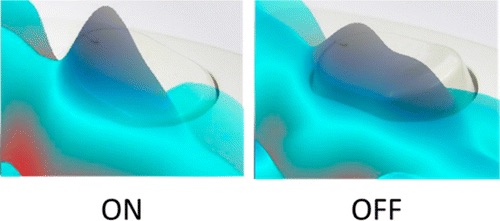We demonstrate that a single 4-acetylbiphenyl molecule adsorbed along the dimer row of a Si(100)-(2 × 1) surface can be reversibly switched between two stable conformations using the tunneling current of a scanning tunneling microscope. The experiment supported by density functional theory calculations demonstrates that the molecule by switching selectively passivates and depassivates a dangling-bond pair on the silicon surface, opening new routes for the logical input in dangling-bond-based atomic-scale circuits.

We demonstrate that a single 4-acetylbiphenyl molecule adsorbed along the dimer row of a Si(100)-(2 × 1) surface can be reversibly switched between two stable conformations using the tunneling current of a scanning tunneling microscope. The experiment supported by density functional theory calculations demonstrates that the molecule by switching selectively passivates and depassivates a dangling-bond pair on the silicon surface, opening new routes for the logical input in dangling-bond-based atomic-scale circuits.
